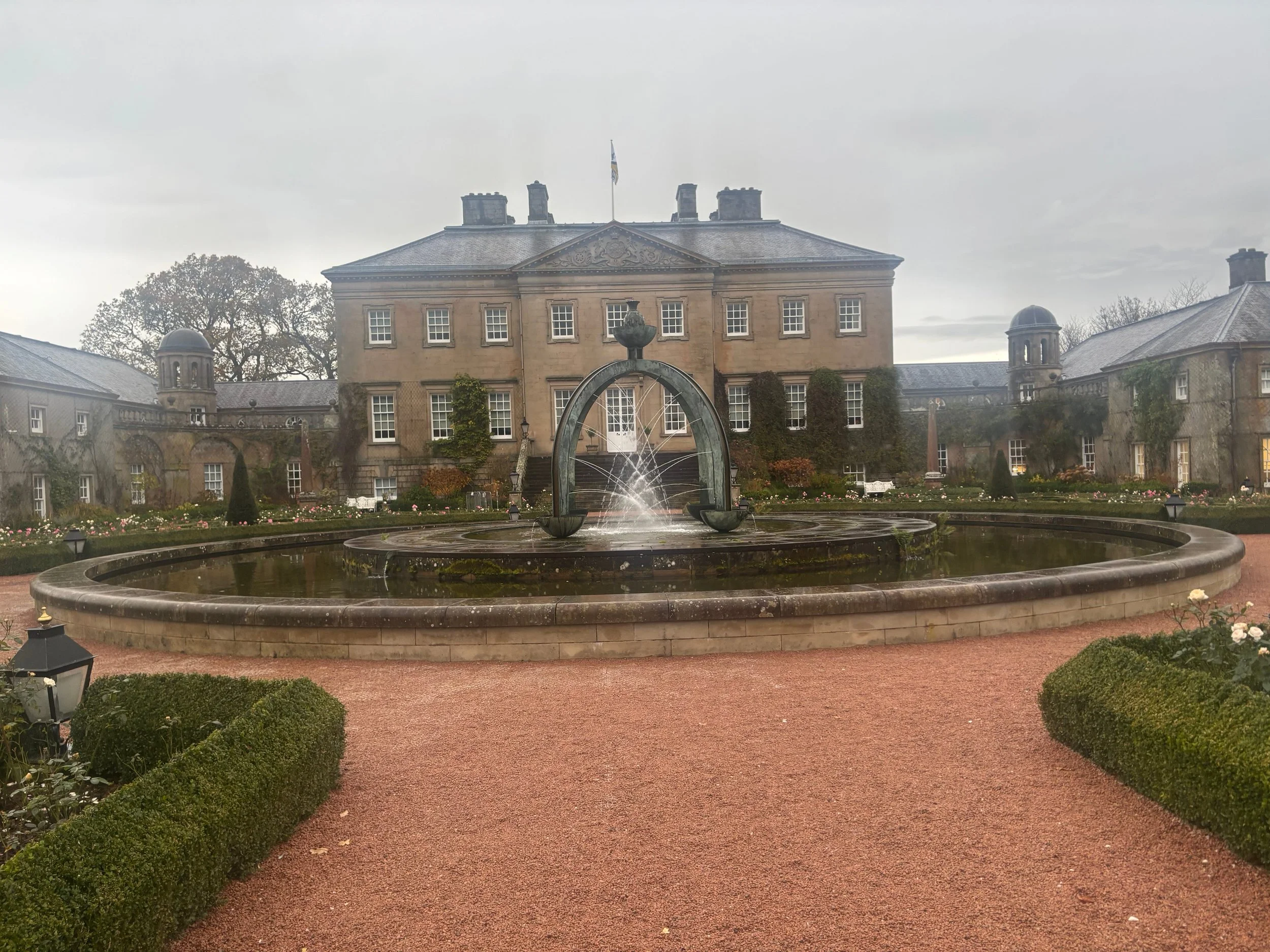Learn More About Shakaila Forbes-Bell AKA TV's Fashion Psychologist who Tamara took to Dumfries House Last Week.
Yes, fashion psychology is a thing, and it's brilliant!
Shakaila Forbes-Bell, Professor Natascha von Hirschhausen, Laura Gerte and Tamara Cincik (chairing) at The King’s Foundation x Fashion Council Germany Youth Conference at Dumfries House last week.
I have known Shakaila for a number of years. She was an early adopter of Fashion Roundtable, attending our events. I asked her to speak at one of our weekly Friday afternoon lockdown webinars, where I would invite key speakers to support our community and tackle issues such as mental health, women in business, and fashion activism. I felt this was an important touchpoint for people to know there was a weekly point of contact, when so many of us felt so alone and disconnected. I believe those weekly meetings for some in our audience were a life-line, I knew they were important, as so many viewers messaged me or the Fashion Roundtable Instagram to say what those weekly sessions meant to them. Shakaila kindly gave her time for one of the webinars.
So I was delighted that she could join me last week for the Youth Conference at Dumfries House. I am always alert to the fact that many teenagers and young adults lived through the lockdown during a key part of their emotional development, and its impacts are only just being understood. I am sure the power of psychology - including fashion psychology - as a tool for cognitive and emotional wellbeing will become increasingly researched and referred to in the coming years, as these young people reach maturity and the workforce.
I attended Shakaila’s book launch at The Conduit for Big Dress Energy, and appeared on her Big Dress Energy podcast alongside Eshita Kabra-Davies, the Founder and CEO of ByRotation (the peer-to-peer rental platform). I am sharing here some questions I have after spending a few days with Shakaila in Scotland last week, to learn more about her work and ideas on fashion as a tool for both positive change, also lean in on her expertise on the power of colour. Shakaila spoke about colour psychology on the panel talk I hosted at Dumfries House, and it was - I hope you’ll agree - totally fascinating.
By the way, Dumfries House is now officially my Scottish happy place. The second largest employer in the area, and a totally magical place to visit or study, with free access to the stunning gardens.
Please let me know what you think of the interview,
Thanks so much!
Tamara.
1) Shakaila, going back to basics, what is fashion psychology and how can it impact us?
Clothing plays a dual role: it is both a mirror (reflecting the self) and a megaphone (projecting identity outward). Fashion psychology enables us to explore the deeper meaning behind seemingly mundane acts, such as getting dressed. The practice explores various topics, such as the psychological impact of clothing and beauty on the everyday person, the external and internal motivations behind consumer behaviour, the link between identity and style, and much more. The theory of enclothed cognition reveals that we internalise the meaning we give to our clothes, which, in turn, changes the way we think and act. Additionally, first impressions are formed in under a second, meaning that our clothes and appearance serve as a form of non-verbal communication. Fashion psychology is the language of that communication and empowers us with knowledge of what our clothes are communicating so we can dress in a way that feels authentic to us.
2) I worked as a stylist for 20 years, working with magazines, celebrities and brands, what do you think is the key difference between styling and fashion psychology, if any?
There is no difference. I often do styling segments on This Morning and have styled people as part of The Wearapy Show: my new fashion psychology YouTube makeover series. Stylists also comprise the largest cohort in my online fashion psychology course. This is because stylists intuitively understand that their clients don’t simply want them to look good; they want stylists to make them feel good, to help them step into a new role, to enter a new era of their lives, to build their confidence, and so much more. Fashion psychology provides empirical backing to the life-affirming experience that stylists provide.
3) From your book Big Dress Energy, to working on TV and now with your new The Wearapy Show on YouTube, it is clear that you are very driven to share your message. What do you think that message is and what tips can you give people who feel stuck in a style rut?
My message is that many of us are fortunate to live in a society where we have control over the clothes we wear and how we choose to represent ourselves each day, a privilege that we often take for granted. Clothes, beauty, and hair are all powerful tools to strengthen your identity and presence in any space you choose to inhabit, so you should treat them as such. If you’re stuck in a style rut, instead of thinking about trends, consider how certain styles make you feel. Acknowledge those feelings and use them to curate a wardrobe that honours your emotions and your authentic identity.
4) The Wearapy Show feels like a very positive watch. When I was younger, I was not a fan of Trinny and Susannah, as I found them a bit rude when I know - from styling - that people in their underwear in front of a mirror are at their most vulnerable. How do you manage the balance of being positive, with pushing your guests to challenge themselves.
Styling everyday people is such an intimate experience but nothing beats those micro expressions (that sway in their hips, that glimmer in their eyes) that you see when you’ve put them in something and they finally see themselves in a new light. You’ll see on the show that I push people into outfits that are probably at the extreme end of their comfort zones, but they always include elements that are important to them. For example, Emma, a new mum that we featured in episode two, lost her cool and creative identity after having a child and had to focus on practicality. So I styled her in bold and colourful outfits, but with clip-on earrings, so she wouldn’t have to worry about her daughter yanking them out. It’s about embracing your clients’ daily lives and their realistic concerns, rather than seeing them as a hindrance.
5) Clothes as a tool for personal growth, discuss.
The practice of wardrobe ethnography portrays clothing as a material record of the different versions of our lives. The boots you still own from university, the blazer you wore when you aced a job interview, the hoodie that brought you comfort during the pandemic. When we think about clothes in this way, we can see how they accompany us through the various phases of life. Research also states that we can think of clothes as reflecting three versions of ourselves: The person we are, the person we fear to be and the person we hope to be. In that way, it’s clear that clothes are a tool not only for personal growth but to honour our ever-evolving and sometimes conflicted ways of being. This is why I often shy away from the way capsule wardrobes are presented, with everyone owning the same items which often skews to a minimalist aesthetic. That might be right for some, but feels out of place for others, and if your clothes are completely misaligned with who you are then you will only ever be dressing as the person you ‘fear to be’ and that is when self-doubt creeps in.
6) You came to Dumfries House with me last week for The King’s Foundation x Fashion Council Germany Youth Conference. How did you find it? And what were your thoughts on how the teenagers in the audience for our panel talk, engaged with your work?
I had a fantastic time at the conference. Connecting with the other brilliant panellists provided me with a more nuanced understanding of the myriad of ways people are tackling sustainability and reinforced my belief that we need to ensure psychology remains at the heart of the conversation. The teenagers were incredibly engaged, and several of them came up to me afterwards to discuss their ideas and opinions which warmed my heart!
Shakaila, Natascha, Laura and I at Dumfries House
7) While we were at Dumfries House, you spoke about the Rule of 4, please could you explain this and how this impacts conscious consumption and therefore a more sustainable shopping approach?
4 years - Before you buy something, ask yourself: will you still wear it in four years? Mindless shopping purchases often tend to be fad items with no personal longevity because you didn’t truly envision yourself owning this item for the long term. Avoid this wastefulness by picturing
your future self in the outfit beyond that one social media post. If that image doesn’t look right, walk away.
3 outfits or occasions - If you can envision yourself wearing the thing you’re planning on buying on at least three different occasions or with three different outfits, that’s a surefire way to tell if it has longevity.
2 two deep breaths - When we’re shopping, we get a rush of adrenaline and dopamine that can flood the dorsolateral prefrontal cortex, the part of our brain that helps us make sound decisions. So, take two deep breaths to calm your nervous system and ensure external stimuli are not swaying you, but rather by your own desires and needs.
1 night’s sleep - Put the laptop down, put the hanger back on the rail and lie your head down. It’s the same rule I have when I’m about to send an essay-long text to someone who has annoyed me to no end. After a good night’s sleep, that text looks ridiculous – and the same might go for the coat you’re planning to buy. If you wake up and can’t stop thinking about it, that should signal you’re making the right decision
Mindful shopping is sustainable shopping.
8) I loved the explanation you gave to the impacts colours have on us and how we react to them. I wonder if you could expand on this here?
The mind/body relationship is incredibly dynamic but it’s often the case that where the body goes, the mind follows. When you wear red, orange or yellow, your sympathetic system becomes activated. As a result, you feel more sociable, extraverted, and energetic because you’re responding to your body telling you that it’s time to get the party started. That’s why long wavelength colours are linked to more active emotions. On the other hand, short-wavelength colours have the opposite effect, activating the parasympathetic system telling you to take it easy.
9) How can fashion psychology positively impact us?
Fashion psychology helps us use clothes in a way that supports our well-being instead of undermining it. When we understand the link between what we wear and how we think, feel, and behave, we can dress in ways that boost confidence, lift our mood, reduce decision fatigue, and express our identity with more clarity. It turns getting dressed into a small daily act of self-care and self-growth.
10) What’s next for you in 2026?
I am working on creating more content to spread the gospel of Fashion Psychology. I’m also going to create Season 2 of The Wearapy Show. I’m working on a second book and have already lined up a few speaking engagements.
The Wearapy Show - watch on YouTube
Big Dress Energy - buy the book.
Shakaila’s Fashion is Psychology courses.










